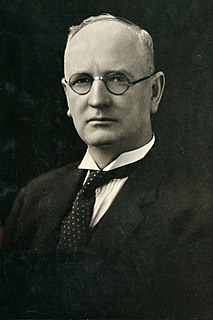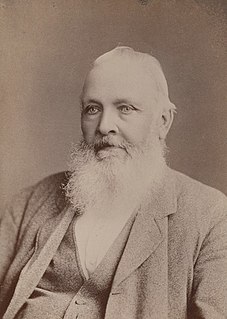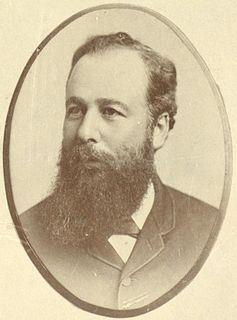Related Research Articles

Bendigo, is a city in Victoria, Australia, located in the Bendigo Valley near the geographical centre of the state and approximately 150 kilometres (93 mi) north-west of Melbourne, the state capital. As of 2019, Bendigo had an urban population of 100,991, making it Australia's 19th-largest city, fourth-largest inland city and the fourth-most populous city in Victoria. It is the administrative centre of the City of Greater Bendigo, which encompasses outlying towns spanning an area of approximately 3,000 km2 and over 111,000 people. Residents of the city are known as "Bendigonians".
Peacock & Son was a tanning and wool-brokering business in the early days of South Australia. Three members of the family were notable public figures: William Peacock was a successful businessman and one of the colony's first parliamentarians. His eldest son Joseph Peacock carried on the family business and was a member of parliament. His youngest son Caleb Peacock was a member of parliament and Mayor of Adelaide from 1875 to 1877, the first such born in the Colony.

Cornish Australians are citizens of Australia who are fully or partially of Cornish heritage or descent, an ethnic group native to Cornwall in the United Kingdom.
May Brothers and Company was an engineering and manufacturing firm founded in Gawler, South Australia in 1885 by Frederick and Alfred May.
Bean Brothers was a company based in Adelaide, South Australia involved in tanning, leathergoods and shipping ventures in the latter half of the 19th century. Bean Brothers Ltd was set up by the principals to consolidate their assets and develop as wool and produce brokers. They also founded the Adelaide and Port Darwin Sugar Company to develop a sugar plantation in the Northern Territory of Australia. Both ventures failed amid acrimony, recrimination and lawsuits.

Stanley R. Whitford was a unionist and Labor politician in the State of South Australia.
Francis Clark and Son was an engineering business in the early days of South Australia, which later became Francis Clark and Sons.

John Stokes Bagshaw was a manufacturer of agricultural machinery in South Australia.

Alfred Muller Simpson, invariably known as Alfred M. Simpson or A. M. Simpson, was a South Australian industrialist, a principal of the manufacturing firm of A. Simpson & Son. He was a member of the South Australian Legislative Council from 1887 to 1894.
George Edward Fulton was an engineer who ran an iron and steel foundry in the early days of South Australia.

Henry Simpson, often referred to as "Captain Simpson", was a ship's captain, ship owner and businessman in South Australia.
William Henry Beaglehole was born at Helston, Cornwall, and came to South Australia on the Prince Regent with his mother, the widow Elizabeth Beaglehole and brother John, arriving in July 1849.

John Moule was a wheat merchant and politician in the colony of South Australia.
The Moonta Cemetery in Moonta, South Australia was established under the Moonta Cemetery Trust in May 1866. Burials had occurred prior to that, with the town having been surveyed and land sold in March 1863. Plans for the cemetery were made in 1867 with walls erected between 1871 and 1876, the front gates made by J. H. Horwood and Co. of Adelaide. J. H. Horwood and Co. also cast the copper bell installed in 1896.
Alfred Hannaford was a South Australian inventor and industrialist, remembered for his wheat pickling machines.
William Henry Gray, generally known as W. H. Gray, was a pioneer colonist of South Australia who amassed considerable wealth through ownership and development of land.
Henry Richard Hancock almost invariably referred to as "Captain Hancock" was a mine superintendent in Moonta and Wallaroo, South Australia. He was noted for his business acumen and the respect with which he was held by both workers and mine owners.
James Hebbard was a miner who became manager of the Great Central Mine, Broken Hill.
John Warren, frequently styled "Captain Warren" or "Captain Jack" after the traditional mining practice, was a mining engineer and mine manager in Australia.
Rev. James Young Simpson was a Wesleyan Methodist minister in South Australia, born in Scotland, a nephew and namesake of James Young Simpson, the celebrated pioneer of chloroform as an anaesthetic.
References
- ↑ "Large Spur Wheel". South Australian Register . Adelaide. 11 February 1863. p. 2. Retrieved 29 January 2012– via National Library of Australia.CS1 maint: discouraged parameter (link)
- ↑ Advertisement South Australian Register 6 November 1866 p.1 Retrieved 19 June 2011
- ↑ Colonial Iron Works South Australian Register 15 May 1869 p.2 Retrieved 19 June 2011
- ↑ Miscellaneous South Australian Advertiser 27 May 1864 p.6 Retrieved 19 June 2011
- ↑ "Death of Mr. Joel Horwood". Bendigo Advertiser . XLVIII (14, 007). Victoria, Australia. 5 May 1900. p. 5. Retrieved 15 August 2016– via National Library of Australia.CS1 maint: discouraged parameter (link)
- ↑ "Probate". The Bendigo Independent (8334). Victoria, Australia. 30 May 1900. p. 4. Retrieved 14 August 2016– via National Library of Australia.CS1 maint: discouraged parameter (link)
- ↑ "Archived copy". Archived from the original on 18 August 2011. Retrieved 18 June 2011.CS1 maint: archived copy as title (link)
- ↑ Sudden Death of Mr. E. J. Horwood Barrier Miner (Broken Hill) 14 November 1940 p.3 Retrieved 19 June 2011
- ↑ Topics of the Day South Australian Advertiser 20 May 1869 p.2 Retrieved 19 June 2011
- ↑ Personal The Argus (Melbourne) 28 September 1915 p.6 Retrieved 19 June 2011
- ↑ "Intimidation at Moonta". South Australian Register . Adelaide. 7 May 1874. p. 4. Retrieved 21 January 2012– via National Library of Australia.CS1 maint: discouraged parameter (link)
- 1 2 "Concerning People". The Register . LXXVIII (20, 728). Adelaide. 18 April 1913. p. 4. Retrieved 15 August 2016– via National Library of Australia.CS1 maint: discouraged parameter (link)
- ↑ Obituary The Advertiser 10 September 1927 p.16 Retrieved 16 June 2011
- 1 2 Cumming, D. A, Moxham, G They Built South Australia Published by the authors February 1986 ISBN 0-9589111-0-X
- ↑ http://www.gabr.net.au/biogs/ABE1793b.htm
- ↑ Horwood Bagshaw Limited The Advertiser 30 June 1954 Retrieved 17 January 2011